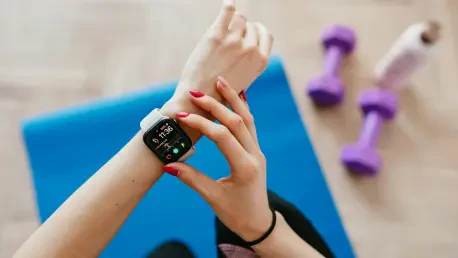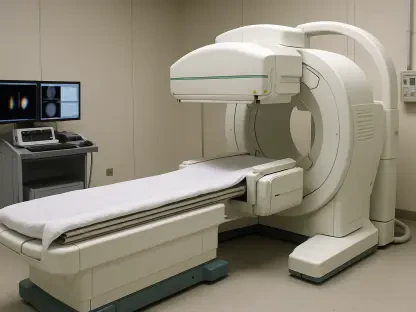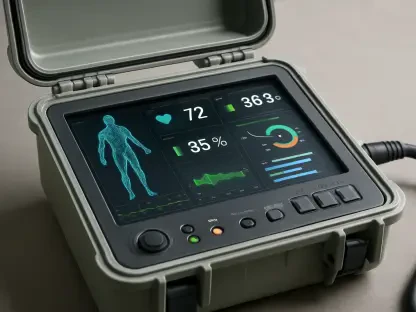Wearable technology has swiftly moved from a niche curiosity to a transformative force that’s reshaping the landscape of health management, personal productivity, and everyday convenience in profound ways, reflecting a broader societal shift toward embracing innovations that empower individuals. Valued at an impressive $62.5 billion in 2023, the wearable tech market is on a steep upward trajectory, with projections estimating a staggering growth to $198.8 billion by 2032, fueled by a robust compound annual growth rate of 13.73% from now through the next several years. No longer just gadgets for tech enthusiasts, devices like smartwatches and fitness bands have become as commonplace as smartphones, seamlessly integrating into routines to offer real-time insights on everything from heart rates to sleep patterns. This surge reflects a broader societal shift toward embracing technology that empowers individuals to live healthier and more connected lives. As wearables continue to evolve, their impact is felt across diverse domains, making them indispensable tools for both personal and professional growth. This exploration delves into the myriad ways these innovations are enhancing wellness, workplace dynamics, and daily interactions.
Empowering Wellness: Wearables as Health Guardians
The realm of personal health and wellness has been dramatically transformed by wearable technology, which equips users with unprecedented control over their physical well-being. Devices such as the Apple Watch and Fitbit Charge 5 have transcended basic fitness tracking to deliver sophisticated features like electrocardiogram readings, blood oxygen level monitoring, and detailed sleep analytics. These advancements allow individuals to keep a close eye on vital health metrics without stepping into a doctor’s office. Notably, studies from institutions like Stanford University have revealed that wearables can detect early indicators of serious conditions, such as COVID-19, even before symptoms become apparent. This capability positions these devices as potential lifesavers, bridging the gap between everyday convenience and critical medical foresight, and fostering a culture of proactive health management among users and healthcare providers alike.
Beyond individual empowerment, wearable technology is redefining preventive care by making it more accessible and personalized than ever before. With the ability to track trends in heart rate variability or alert users to irregular rhythms, these devices serve as constant health companions, encouraging timely interventions. For those managing chronic conditions like diabetes or hypertension, wearables provide a non-intrusive way to monitor vital signs and share data directly with medical professionals for remote consultations. This integration not only enhances patient outcomes but also reduces the burden on healthcare systems by minimizing unnecessary visits. The democratization of such advanced health tools means that a broader population can now prioritize wellness, shifting the focus from reactive treatments to sustained prevention strategies that align with modern lifestyle demands.
Boosting Efficiency: Wearables in Corporate Wellness Programs
In professional environments, wearable technology is carving out a significant role by enhancing employee well-being through structured corporate wellness initiatives. Many forward-thinking companies have partnered with fitness tracker providers to distribute devices that monitor activity levels, stress, and sleep quality among their workforce. Such programs, exemplified by collaborations like Salesforce with Fitbit, enable employees to receive tailored health insights, encouraging habits that combat sedentary lifestyles. This tech-driven approach not only promotes a healthier workforce but also fosters a sense of community and accountability within organizations, as employees often engage in friendly challenges or shared fitness goals, ultimately contributing to a more vibrant workplace culture.
The benefits of integrating wearables into corporate settings extend beyond individual health to measurable organizational gains. Employers gain access to aggregated, anonymized data that can reveal trends in employee wellness, helping to tailor benefits or interventions that address specific needs like stress management or ergonomic improvements. This data-centric strategy has been shown to enhance productivity by reducing absenteeism and boosting morale, as workers feel supported in their personal health journeys. Furthermore, the adoption of wearables signals a company’s commitment to innovation and employee care, which can be a powerful tool for attracting and retaining talent in competitive industries. As these programs expand, they underscore the growing recognition of health as a cornerstone of professional success.
Connecting Lives: The Role of IoT in Wearable Integration
The power of wearable technology is amplified through its seamless integration with the Internet of Things (IoT), creating a connected ecosystem that enhances daily functionality. By linking with smartphones, health applications, and smart home systems, wearables deliver real-time updates and personalized feedback that adapt to user behaviors. Whether it’s a smartwatch reminding someone to stand after prolonged sitting or syncing workout data to a fitness app for detailed analysis, this connectivity ensures that information is always at hand. The result is a more cohesive experience where technology anticipates needs and integrates effortlessly into routines, making wearables not just tools but integral parts of lifestyle management.
This interconnectedness also opens doors to smarter living by enabling wearables to interact with other devices for greater convenience and efficiency. Imagine a fitness band that adjusts a smart thermostat based on post-workout body temperature or a device that logs dietary intake through integration with a kitchen app. Such capabilities highlight how IoT transforms wearables into central hubs for orchestrating various aspects of daily life, from health tracking to home automation. This synergy not only enhances user engagement by providing actionable insights but also drives the adoption of smart technologies across demographics. As IoT continues to evolve, the potential for wearables to create even more tailored and responsive experiences promises to further embed them into the fabric of everyday existence.
Versatile Solutions: Wearables Across Fitness and Healthcare
The wearable tech market showcases remarkable versatility, addressing a spectrum of needs from casual fitness tracking to groundbreaking medical applications. Wrist-worn devices, including smartwatches and fitness bands, lead the consumer electronics segment, appealing to athletes, professionals, and casual users alike with their accessible design and multifunctional features. These gadgets track everything from steps to calories burned, catering to a wide audience seeking to maintain or improve their physical activity levels. Their dominance in the market reflects a universal desire for tools that support healthier lifestyles, while continuous innovations ensure they remain relevant by incorporating more advanced sensors and user-friendly interfaces.
In parallel, the healthcare sector is witnessing rapid growth in wearable applications, particularly with devices designed for medical monitoring and chronic disease management. Innovations like Nemaura’s sugarBEAT, a non-invasive glucose monitoring system, exemplify how wearables are revolutionizing care for conditions like diabetes by providing critical data without the discomfort of traditional methods. This technology allows patients and doctors to make informed decisions remotely, enhancing the quality of telehealth services and reducing hospital visits. The dual focus on fitness and medical needs demonstrates the adaptability of wearables, as they bridge the gap between everyday convenience and specialized care, offering solutions that cater to diverse populations and health challenges with equal efficacy.
Looking Ahead: The Lasting Impact of Wearable Innovations
Reflecting on the journey of wearable technology, it’s evident that these devices have already reshaped critical aspects of health monitoring, workplace dynamics, and personal connectivity by blending seamlessly into daily routines. Their ability to provide real-time health insights and foster corporate wellness has marked a significant shift in how society approaches well-being and productivity. As the market expanded, the focus on accessibility and advanced features has ensured that wearables became tools for everyone, from fitness enthusiasts to patients managing chronic conditions.
Moving forward, the challenge lies in sustaining this momentum through continued innovation and broader accessibility. Stakeholders should prioritize developing wearables with enhanced AI capabilities for predictive health analytics, ensuring they remain ahead of user needs. Additionally, efforts to reduce costs will be crucial in making these technologies available to emerging markets, further closing gaps in healthcare access. As collaborations between tech giants and healthcare providers grow, the potential for wearables to address global health challenges offers a promising horizon, paving the way for smarter, more inclusive solutions.









